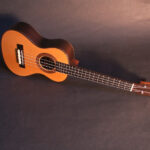Starting a musical journey early in life can be incredibly enriching for children. Introducing them to instruments like the guitar can foster creativity, discipline, and a lifelong love for music. Children’s toy guitars, especially those designed with learning in mind, can be an excellent first step. You might wonder if these smaller, simpler instruments can truly help a child learn and if the skills gained are transferable to a full-sized guitar later on. Let’s explore these questions and understand why a children’s toy guitar could be the perfect gateway to musical exploration for your child.
Unlocking Musical Potential with a Toy Guitar
One common concern is whether a toy guitar is a “real” instrument. The answer is a resounding yes! Consider this: even on a standard 6-string guitar, many chords only utilize three notes. Children’s toy guitars, like Loog guitars, are designed to play genuine chords, allowing children to learn and play actual songs. While the sound might not be as resonant as a concert guitar, this simplicity is actually an advantage for young learners. It provides a less overwhelming and more approachable introduction to the instrument.
From Toy Guitar to Stage Guitar: A Seamless Transition
A fantastic benefit of starting with a children’s toy guitar is the smooth transition to a standard 6-string guitar. Quality toy guitars, such as Loog models, use the same first three strings and tuning as a 6-string guitar. This clever design means everything a child learns on their toy guitar – finger placement, chord shapes, basic music theory – directly applies to a standard guitar. It’s not a completely different instrument; it’s a simplified, kid-friendly version. Think of it as learning to ride a bicycle with training wheels – the core skills are the same, and transitioning to a regular bike becomes much easier. You can even use standard guitar chord charts and songbooks; just focus on the first three strings and ignore the rest!
Age-Appropriate Guitars for Every Young Musician
Choosing the right size instrument is crucial for a child’s comfort and learning progress. Children’s toy guitars come in various sizes to suit different age groups. For the youngest beginners, around 3 years old and up, the Loog Mini is an ideal choice. As children grow, generally around 6 years old and up, the Loog Pro offers a slightly larger size that remains comfortable and manageable. For older kids, approximately 9 years and up, the Loog Pro VI provides a size that bridges the gap towards full-sized guitars. This age-appropriate sizing ensures that children can play comfortably and without strain, making learning more enjoyable and effective.
More Than Just a Toy: A Real Musical Instrument
It’s important to dispel the myth that children’s toy guitars are only for kids. While designed with young learners in mind, these instruments appeal to a wider audience. Many adults, including parents, grandparents, and even professional guitarists, appreciate the simplicity and portability of these guitars. They are perfect for casual playing, travel, or simply enjoying the pure fun of making music. So, investing in a children’s toy guitar isn’t just for your child; it can be an instrument the whole family can enjoy.
Tuning In: Simple and Standard
Tuning a guitar can seem daunting to beginners, but children’s toy guitars simplify this process too. Loog guitars, for example, use standard GBE tuning, the same as the top three strings of a 6-string guitar. This familiarity is another advantage for future transition. While standard tuning is recommended for learning transferable skills, these guitars also encourage musical exploration. Children (and adults!) can experiment with different tunings like Open A or Open G, fostering creativity and a deeper understanding of musical sounds.
Left-Handed Options Available
No child should be excluded from learning music due to their handedness. Recognizing this, some manufacturers, like Loog, offer left-handed versions of their children’s toy guitars. This inclusivity ensures that left-handed children have the same opportunity to learn and enjoy playing the guitar comfortably, without having to adapt to a right-handed instrument.
Acoustic or Electric: Which Toy Guitar is Best to Start?
Choosing between an acoustic or electric guitar is a common question for beginners of all ages. Interestingly, some argue that electric guitars can be easier to start with because the strings are often closer to the fretboard, making them more comfortable to press down. For children’s toy guitars, the choice really comes down to personal preference. Both acoustic and electric models offer a fantastic starting point. Consider your child’s interests and the type of music they enjoy when making this decision.
Toy Guitars in Education: A School-Friendly Instrument
The benefits of children’s toy guitars extend beyond individual learning. Their simplicity, durability, and age-appropriateness make them ideal for educational settings. Schools and institutions looking to introduce music to children can benefit from special pricing and educational programs offered by some children’s toy guitar brands like Loog. These programs often provide structured learning materials and support, making it easier for educators to incorporate guitar playing into their curriculum.
Conclusion: Start the Musical Adventure Today
Children’s toy guitars are more than just playthings; they are real musical instruments designed to spark a love for music and provide a solid foundation for future guitar playing. They offer a simplified, age-appropriate, and enjoyable way for children to learn chords, melodies, and develop essential musical skills. Whether you choose an acoustic or electric model, a children’s toy guitar can be the perfect first step on a lifelong musical adventure. Consider exploring brands like Loog Guitars to find a high-quality instrument that will inspire your child’s musical journey.

